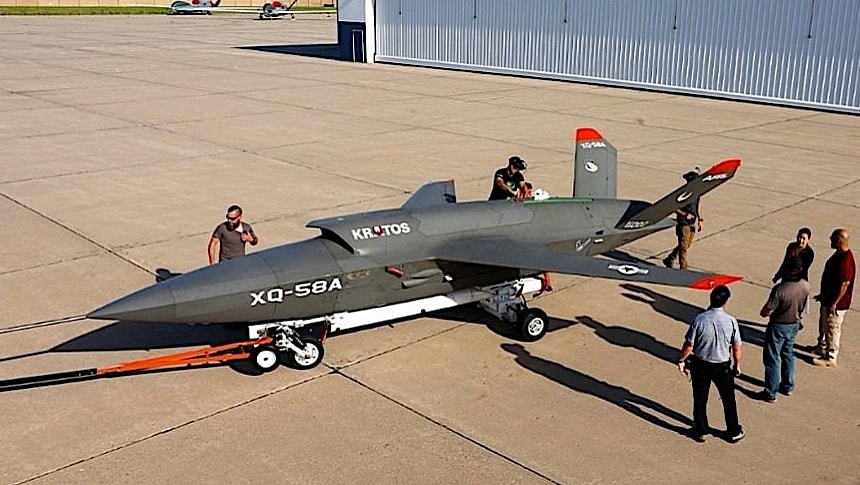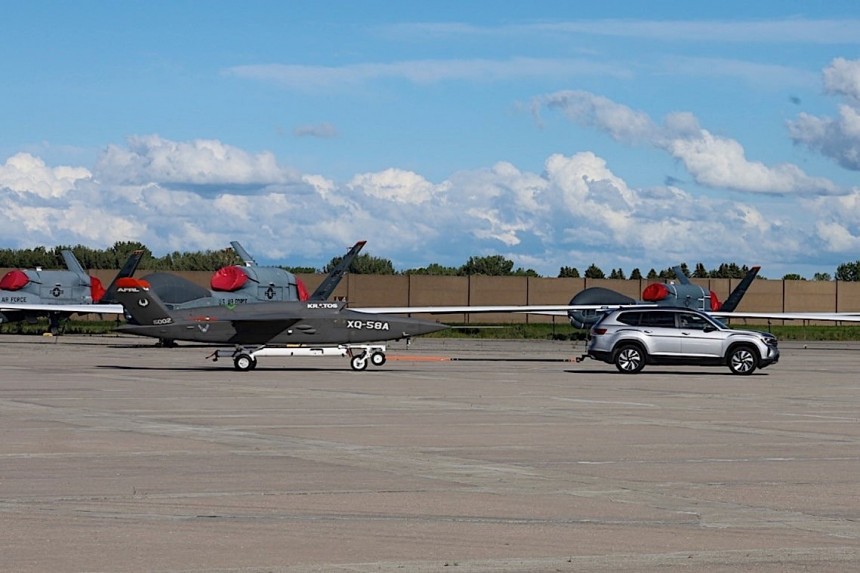Valkyries are some of the most impressive mythological creatures around. Born in the minds of the people living in Northern Europe millennia ago, they are maidens whose sole purpose is to cherry-pick the dead Norse warriors worthy of entering the local version of Heaven, Valhalla. But for the humans of the future, Valkyries will mean a different thing entirely.
And no, I am not talking about the Aston Martin that comes as close as possible to a Formula One car without being restricted to the track. The name has also been chosen to depict not one but two families of military drones that are currently in the works.
One group that uses it for its products is Valkyrie Systems Aerospace, who is working on a couple of hoverjet drones also called Guardian and Eagle. The other, the one that interests us today, is defense contractor Kratos, currently devising the Valkyrie drone.
Also called XQ-58A, the aircraft is supposed to become a combat drone that could be used both as a standalone weapons platform or to support crewed jets in completing their missions. The thing has stealth attributes, is relatively cheap to make (unclear how much so, but we'll trust Kratos on that), and can be either remotely piloted or can fly on its own accord.
The Valkyrie has been out and about ever since 2019, but work on it is far from over. Still under development, it is used for a variety of purposes, from testing new weapons and means of deployment to finding ways of transforming it into a common platform for entire families of drones.
By itself the aircraft is a very capable beast. A single turbofan engine of undisclosed make is what keeps it going, pushing it to a subsonic top speed of Mach 0.85 (652 mph / 1,050 kph). It can keep going for as much as 2,449 miles (3,941 km), carrying into combat a number of weapons, including Joint Direct Attack Munition (JDAM) and small-diameter bombs.
The drone can carry its cargo to as high up as 45,000 feet (13.7 km) in either its internal weapons bay or hardpoints installed mid-wing.
But it's not these capabilities that are of interest to us today, but the drone's methods of getting airborne. And following its most recent exploit, there are now three of them.
You see, one peculiar thing about the Valkyrie is that it doesn't come with conventional landing gear. When taking off, it relied so far on a ground-bassed launcher equipped with rocket boosters. This method is called rocket assist takeoff (RATO) and it is ideal for use in locations where there are no no runway or prepared stretches of road available.
After completing its mission, it came back down by means of a parachute, with the touchdown softened by air cushions.
The second way of getting the drone airborne was just demonstrated this week by Kratos, and it involves a trolley that effectively allows the aircraft to use conventional runways, or even straight stretches of road, to depart a location.
The official name of this unofficial chariot is Kratos Trolley Launch System (KTLS), and it's basically a simple wheeled platform with no engines of its own.
The drone is perched on top of the unpowered trolley, and it then uses its own engine to accelerate to takeoff speeds, just like you'd get in such a maneuver performed by a conventional airplane. When the lift-off speed is reached, the drone soars to the sky, and the trolley detaches.
To avoid damage to the wheeled platform and bring back to the ground safely, drogue chutes are used. Kratos shared a very short video of how the procedure is supposed to work, as recorded at the North Dakota Grand Sky Range, and you can have a look at it below this text.
The defense contractor says that both the RATO and KTLS ways of launching the Valkyrie allow for the drone to be loaded with the maximum amount of fuel and payload. That's because the lack of a landing gear both clears up space and brings the weight of the aircraft down.
I said earlier there are three ways of getting the drone airborne, but so far its maker has not shared any details on the third method.
The Valkyrie is not the only drone Kratos is working on. Others, also named after gods and goddesses or somehow related to ancient mythology (Mako, Air Wolf, Athena, Apollo), are also in the works.
And so is a hypersonic test vehicle called Erinyes. The thing was flown for the first time in June, opening the doors for the defense industry to test various technologies at tremendous speeds: over Mach 5, or 3,836 mph (6,173 kph).
Back to the Valkyrie, it will probably become the backbone of an entire family of new types of drones. The first one, the General Atomics XQ-67A OBSS, had it first flight recently as well.
One group that uses it for its products is Valkyrie Systems Aerospace, who is working on a couple of hoverjet drones also called Guardian and Eagle. The other, the one that interests us today, is defense contractor Kratos, currently devising the Valkyrie drone.
Also called XQ-58A, the aircraft is supposed to become a combat drone that could be used both as a standalone weapons platform or to support crewed jets in completing their missions. The thing has stealth attributes, is relatively cheap to make (unclear how much so, but we'll trust Kratos on that), and can be either remotely piloted or can fly on its own accord.
The Valkyrie has been out and about ever since 2019, but work on it is far from over. Still under development, it is used for a variety of purposes, from testing new weapons and means of deployment to finding ways of transforming it into a common platform for entire families of drones.
By itself the aircraft is a very capable beast. A single turbofan engine of undisclosed make is what keeps it going, pushing it to a subsonic top speed of Mach 0.85 (652 mph / 1,050 kph). It can keep going for as much as 2,449 miles (3,941 km), carrying into combat a number of weapons, including Joint Direct Attack Munition (JDAM) and small-diameter bombs.
But it's not these capabilities that are of interest to us today, but the drone's methods of getting airborne. And following its most recent exploit, there are now three of them.
You see, one peculiar thing about the Valkyrie is that it doesn't come with conventional landing gear. When taking off, it relied so far on a ground-bassed launcher equipped with rocket boosters. This method is called rocket assist takeoff (RATO) and it is ideal for use in locations where there are no no runway or prepared stretches of road available.
After completing its mission, it came back down by means of a parachute, with the touchdown softened by air cushions.
The second way of getting the drone airborne was just demonstrated this week by Kratos, and it involves a trolley that effectively allows the aircraft to use conventional runways, or even straight stretches of road, to depart a location.
The official name of this unofficial chariot is Kratos Trolley Launch System (KTLS), and it's basically a simple wheeled platform with no engines of its own.
To avoid damage to the wheeled platform and bring back to the ground safely, drogue chutes are used. Kratos shared a very short video of how the procedure is supposed to work, as recorded at the North Dakota Grand Sky Range, and you can have a look at it below this text.
The defense contractor says that both the RATO and KTLS ways of launching the Valkyrie allow for the drone to be loaded with the maximum amount of fuel and payload. That's because the lack of a landing gear both clears up space and brings the weight of the aircraft down.
I said earlier there are three ways of getting the drone airborne, but so far its maker has not shared any details on the third method.
The Valkyrie is not the only drone Kratos is working on. Others, also named after gods and goddesses or somehow related to ancient mythology (Mako, Air Wolf, Athena, Apollo), are also in the works.
And so is a hypersonic test vehicle called Erinyes. The thing was flown for the first time in June, opening the doors for the defense industry to test various technologies at tremendous speeds: over Mach 5, or 3,836 mph (6,173 kph).
Back to the Valkyrie, it will probably become the backbone of an entire family of new types of drones. The first one, the General Atomics XQ-67A OBSS, had it first flight recently as well.








